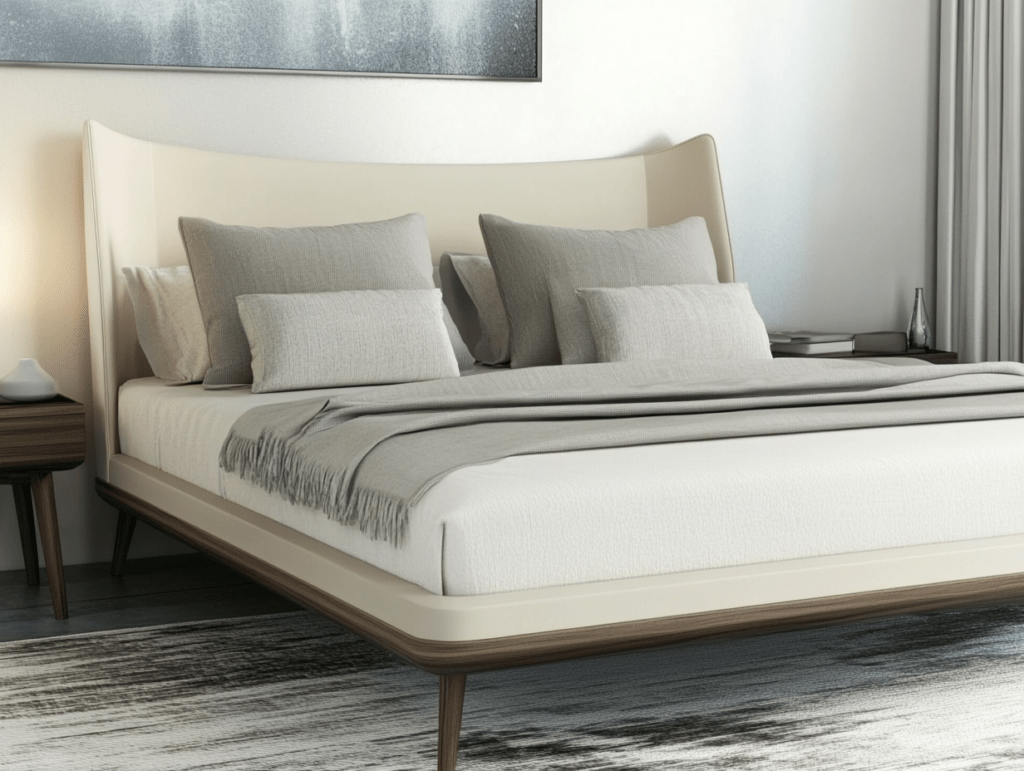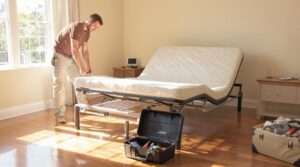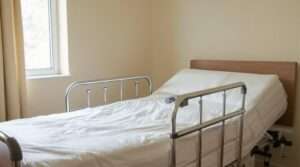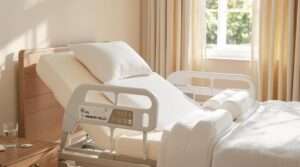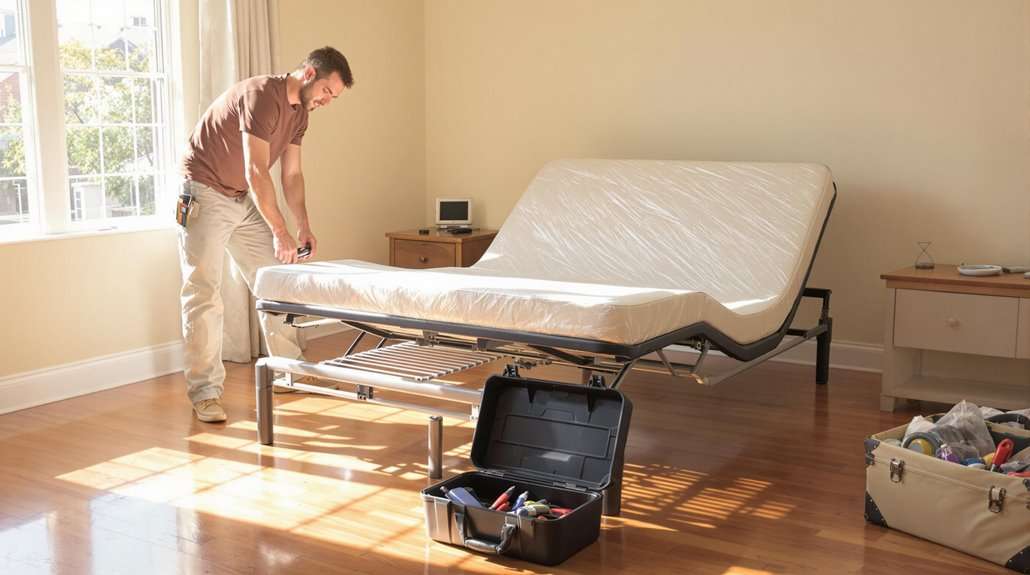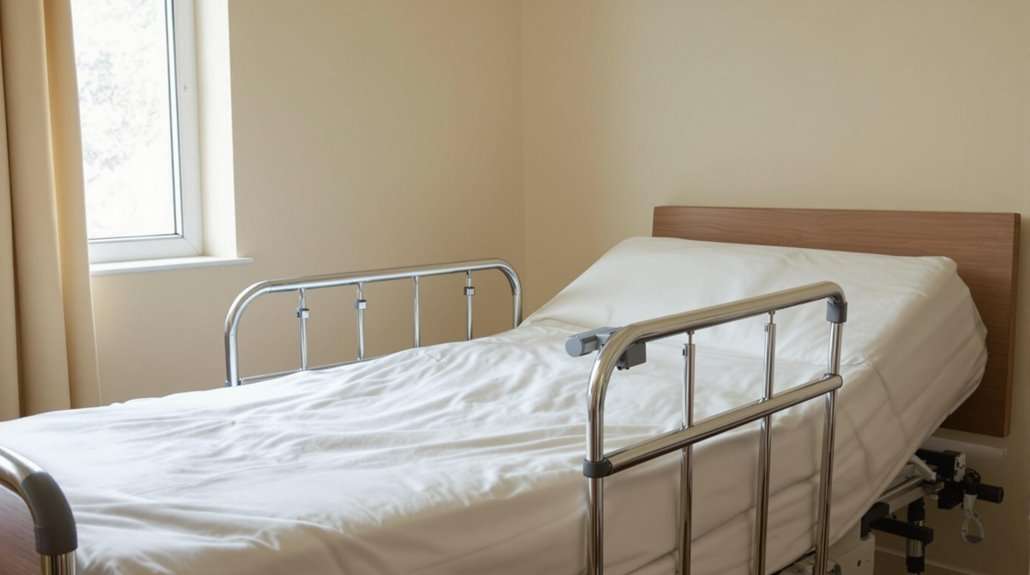A low-profile bed is a specialized sleeping solution designed for seniors, typically featuring a lower height of 8-10 inches from the floor. It’s suitable for many older adults, especially those with mobility challenges, as it reduces fall risks and enhances accessibility. These beds often include adjustable features, side rails, and pressure-relieving mattresses for added comfort and safety. While they offer numerous benefits, including easier transfers and caregiver support, potential drawbacks include limited under-bed storage and challenges for some caregivers. To determine if a low-profile bed is right for you or your loved one, consider individual health needs, mobility levels, and consult with healthcare professionals. Further exploration can reveal additional insights into senior-friendly sleeping solutions.
📋✅
-
Low-profile beds are designed for seniors, featuring heights of 8-10 inches from the floor with adjustable options.
-
They enhance safety by reducing fall risk and potential injuries by up to 50% for older adults.
-
These beds improve accessibility for those with mobility issues, promoting independence in getting in and out of bed.
-
Low-profile beds are generally suitable for seniors, but individual assessments are crucial to determine the best fit.
-
Potential drawbacks include challenges for caregivers and reduced under-bed storage space.
Defining Low-Profile Beds
Low-profile beds stand out as specialized sleeping solutions designed with seniors in mind. These beds typically feature a lower overall height compared to standard beds, making them easier to access for individuals with limited mobility or those using mobility aids. The primary characteristic of a low-profile bed is its reduced distance from the floor to the top of the mattress, usually ranging between 15 to 23 inches.
When defining low-profile beds, it’s vital to take into account their unique design features. These often include sturdy side rails for added safety, adjustable head and foot positions for comfort, and easy-to-reach controls. Low-profile beds are engineered to accommodate various mattress types, guaranteeing mattress compatibility with different thicknesses and materials.
Understanding the specific needs of seniors is significant when selecting a low-profile bed. You’ll want to assess factors such as the user’s height, weight, and mobility level. Additionally, it’s important to evaluate the room’s layout and any potential obstacles that might affect bed placement. By carefully reviewing these aspects, you can confirm that the chosen low-profile bed provides ideal safety, comfort, and independence for the senior in your care.
Benefits of Low-Profile Beds
Having defined low-profile beds, it’s important to understand their advantages. These beds offer several benefits for seniors and their caregivers. Primarily, they enhance safety by reducing the risk of falls. With a lower height, it’s easier for seniors to get in and out of bed independently, promoting autonomy and reducing strain on caregivers.
Low-profile beds often incorporate comfort features designed specifically for older adults. These may include pressure-relieving mattresses, adjustable head and foot sections, and built-in safety rails. Such features can help alleviate pain, improve circulation, and prevent bedsores.
The design aesthetics of low-profile beds are typically more home-like, blending seamlessly with existing decor. This can help maintain a sense of normalcy and dignity for seniors, especially those adapting from traditional beds.
Additionally, these beds facilitate easier care provision. Caregivers can assist with personal hygiene, dressing, and medical procedures without straining their backs. The lower height also allows for better eye-level communication, fostering stronger connections between seniors and their caregivers.
Lastly, low-profile beds can accommodate medical equipment more discreetly, maintaining a comfortable living environment while meeting healthcare needs.
Potential Drawbacks
Despite their many advantages, low-profile beds come with potential drawbacks that you should consider. These beds may present accessibility challenges for caregivers, as the lower height can strain their backs when providing assistance. Additionally, some seniors might find it difficult to get in and out of a very low bed, particularly those with limited mobility or joint issues.
Mattress compatibility can also be a concern with low-profile beds. You’ll need to ascertain that your chosen mattress works well with the bed frame and doesn’t compromise the intended low height. Some potential issues include:
- Limited under-bed storage space
- Reduced airflow beneath the mattress
- Difficulty using certain medical equipment, such as bed lifts or trapeze bars
It’s vital to assess your specific needs and those of the senior in your care before deciding on a low-profile bed. Consider consulting with a healthcare professional or occupational therapist to determine if this type of bed is suitable. While low-profile beds can offer significant benefits, they may not be the best choice for everyone. Carefully weigh the pros and cons to guarantee you’re making the most appropriate decision for the senior’s comfort, safety, and overall well-being.
Suitability for Seniors
When it comes to seniors’ sleeping arrangements, low-profile beds often stand out as a suitable option. These beds address many of the challenges older adults face, particularly those with mobility issues. The reduced height makes it easier for seniors to get in and out of bed safely, reducing the risk of falls and injuries.
Low-profile beds are especially beneficial for individuals with arthritis, joint pain, or limited range of motion. They allow seniors to maintain independence by minimizing the need for assistance during bedtime routines. Additionally, these beds can accommodate various comfort preferences, as they’re compatible with different mattress types and thicknesses.
For caregivers, low-profile beds offer practical advantages. They facilitate easier transfers between bed and wheelchair, reducing strain on both the caregiver and the senior. The lower height also allows for better access during medical procedures or personal care tasks.
However, it’s crucial to evaluate individual needs when choosing a bed. Some seniors may prefer a slightly higher bed for easier positioning or to alleviate respiratory issues. Consulting with healthcare professionals can help determine if a low-profile bed is the most suitable option for a senior’s specific requirements and living situation.
Safety Considerations
Safety is paramount when evaluating low-profile beds for seniors. These beds offer several safety advantages due to their lower height, which can greatly reduce the risk of falls and related injuries. When assessing a low-profile bed for fall prevention, you’ll want to take into account the following factors:
- Bed height: Verify the bed’s surface is at a level that allows the senior to easily sit on the edge with their feet flat on the floor.
- Stability: Check that the bed frame is sturdy and doesn’t wobble when weight is applied.
- Side rails: Think about adding adjustable side rails for extra support and fall prevention.
Low-profile beds typically range from 15 to 23 inches in height, making it easier for seniors to get in and out of bed safely. This reduced height minimizes the distance between the bed and the floor, decreasing the potential impact of a fall. Additionally, these beds often come with features like locking wheels and non-slip surfaces to enhance stability. When selecting a low-profile bed, prioritize models with smooth edges and rounded corners to prevent accidental bumps or bruises. Remember to assess the senior’s mobility needs and consult with healthcare professionals to verify the bed’s safety features align with their specific requirements.
Alternatives for Older Adults
While low-profile beds offer many benefits for seniors, they’re not the only option available. You might consider other alternatives that can provide comfort and safety for older adults. Adjustable beds are a popular choice, allowing you to raise or lower different sections of the mattress to accommodate various sleeping positions and health needs. These beds can help with issues like acid reflux, circulation problems, and back pain.
Another option is a hospital-style bed, which offers maximum adjustability and medical-grade features. These beds can be particularly useful for seniors with limited mobility or those requiring frequent medical care at home. Ergonomic designs in standard-height beds can also provide enhanced support and comfort without the low profile.
For those who prefer to keep their existing bed, you can explore bed rails, transfer poles, or bed steps to improve safety and ease of access. Additionally, mattress toppers or specialized mattresses with pressure-relieving properties can enhance comfort and reduce the risk of bedsores. When considering alternatives, always consult with healthcare professionals to guarantee the chosen option meets the specific needs of the older adult in your care.
Frequently Asked Questions
How Much Do Low-Profile Beds Typically Cost?
Imagine your wallet as a gentle breeze, guiding you through the landscape of low-profile beds. You’ll find a range of options to suit your budget, typically costing between $200 and $1,500. Budget options start around $200-$400, while mid-range beds made with quality materials can cost $500-$800. High-end models with advanced features may reach $1,000-$1,500. Remember, investing in a comfortable, supportive bed is essential for your well-being and can greatly impact your quality of life.
Can Low-Profile Beds Accommodate Adjustable Mattresses or Bases?
You’ll find that many low-profile beds are compatible with adjustable bases and mattresses. When considering adjustable compatibility, check the bed frame’s specifications. Some models are designed specifically for this purpose. Your mattress selection is vital; choose one that’s flexible enough to work with an adjustable base. Remember, not all low-profile beds accommodate adjustability, so it’s important to verify before purchasing. This feature can greatly enhance comfort and functionality for those you’re caring for.
Are There Specific Sheet Sizes for Low-Profile Beds?
Imagine you’re shopping for your newly renovated guest room. You’ll find that low-profile beds often use standard sheet sizes, but there are several factors to think about. The low profile design may require deep-pocketed fitted sheets to accommodate the mattress depth. Sheet material is essential; opt for breathable, durable fabrics like cotton or bamboo. While specialized sizes aren’t typically necessary, you might prefer tucking excess material for a neater appearance. Always check your bed’s specific dimensions to guarantee a perfect fit for your guests’ comfort.
Do Low-Profile Beds Require Special Assembly or Installation?
When it comes to low-profile beds, you’ll find that assembly considerations are generally straightforward. Most models come with clear instructions and require basic tools. However, you should pay attention to installation tips, such as guaranteeing a level surface and proper frame alignment. You’ll typically need to attach the headboard, footboard, and side rails. It’s important to follow the manufacturer’s guidelines carefully. If you’re not confident in your assembly skills, consider seeking assistance to guarantee safety and stability.
Can Low-Profile Beds Be Used With Bed Rails or Other Assistive Devices?
You’ll be pleased to know that low-profile beds can indeed be used with bed rails and other assistive devices. Many models offer bed rail compatibility, guaranteeing your safety and comfort. Assistive device options like transfer poles, bed caddies, and overhead trapeze bars can also be incorporated. When selecting these devices, consider the bed’s height and weight capacity. Always consult the manufacturer’s guidelines to guarantee proper installation and use of any additional equipment with your low-profile bed.

